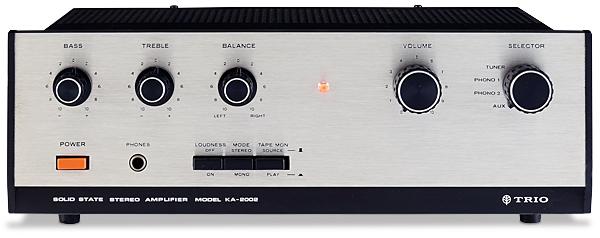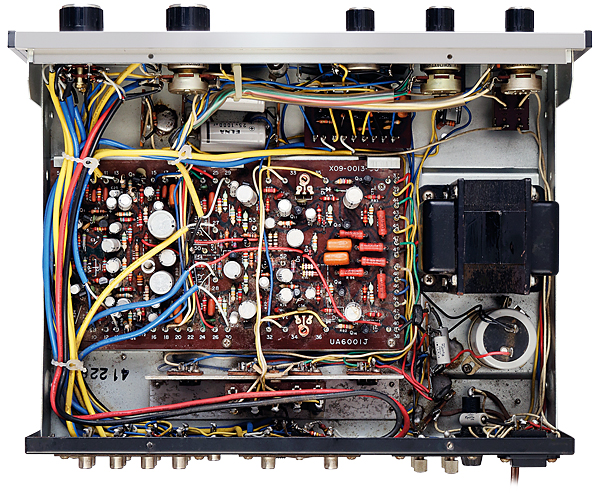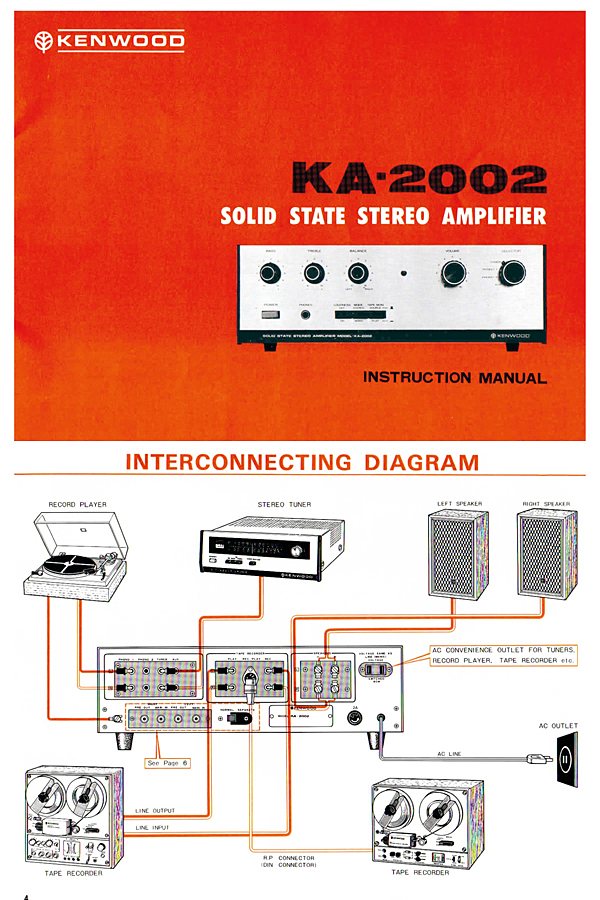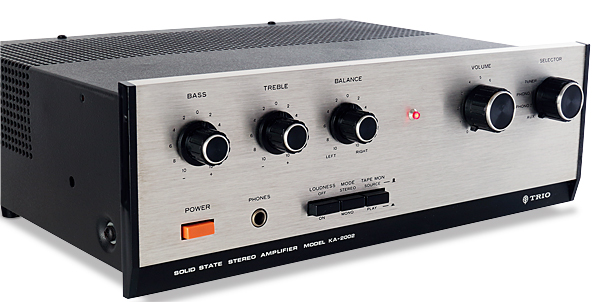Trio/Kenwood KA-2002 Integrated Amplifier

 Attractive, affordable and the first step on the hi-fi highway for many a budding audiophile, is this '70s amp now the perfect introduction to vintage? We find out
Attractive, affordable and the first step on the hi-fi highway for many a budding audiophile, is this '70s amp now the perfect introduction to vintage? We find out
The instantly recognisable Trio/Kenwood KA-2002 is one of those products that is sure to have touched the lives of many readers of Hi-Fi News. A popular first move upmarket from record players and radiograms towards 'proper' hi-fi, this inexpensive amplifier was a frequent choice for enthusiasts taking their initial steps towards serious listening.
Introduced in 1970, the KA-2002 used cool-running and compact solid-state circuitry to deliver a claimed 2x13W/8ohm. This was a healthy figure when compared to the basic set-ups the owner may have just moved on from. Japanese equipment was a relative novelty on the British market at the time, and a few years previously there had been virtually none. Indeed, at first Kenwood sold its products under the Trio brand in the UK to ensure it would not be confused with the high-profile British kitchen appliance manufacturer – a situation that would continue until the 1990s.
Price Is Right
The offer from the Japanese companies would become a familiar one, however. This meant the latest tech combined with a good standard of finish, plus aggressively keen pricing. As a case in point, the Kenwood KA-2002 cost under £40 when the similarly rated, but ageing, Leak Stereo 30 Plus [HFN Sep '20] cost over £60. In addition, Japanese electronic products of this era offered a level of reliability previously unknown to British buyers.

While not a top-end model, the KA-2002 was laid out internally in the same way as its more expensive counterparts. For example, the RIAA eq amplifier for the turntable input was used exclusively for this purpose and switched out of the circuit when not in use. Common practice for small amplifiers at that time (such as the Leak Stereo 30 Plus) was to change its characteristics and use it to provide gain for the other inputs – with an attendant noise penalty. Given that records were likely to be the main source for an amp such as this, the RIAA stage of the KA-2002 had been designed with considerable care.
Pop Star
A particular point of interest was the use of an elevated supply voltage to give good immunity to pops and clicks from imperfect record surfaces, with electronic filtering said to reduce the possibility of hum entering the signal path from this source. The rest of the circuit was divided into the preamp (with active treble and bass controls) and the power amp. Unusually in this class, the pre and power amplifiers could be separated using a switch at the rear. This made possible the use of external filters or a more powerful output stage.

One aspect of the design of equipment intended for the novice user is that it must be more tolerant to misuse than that designed for seasoned experts. Any amplifier's most vulnerable section is its output stage. This must deal with overloads caused by factors such as prolonged periods of operation at full output, unsuitable loudspeaker loads and the accidental short circuiting of the connecting cables. To a great extent, the use of AC coupling between this amp's output transistors and its output connections – by capacitors – removed the possibility of instant destruction by a stray whisker of wire or a poorly connected loudspeaker. But the designers went further in the pursuit of toughness.
Early Warning
The average current flowing in each of the two pairs of output transistors was continuously monitored by a transistorised circuit. If either channel exceeded a predetermined level the input to both of the power stages was muted, protecting the amplifier and giving a clear warning that something was wrong. Once the overload condition cleared, the circuit automatically reset itself. This meant that on most occasions a simple reduction of the volume setting was all that was necessary. The arrangement was greatly preferable to conventional fuses, which users seldom replaced with correctly rated parts. As a result of the care taken in its design and the quality of the components employed, the KA-2002 soon earned an enviable reputation for reliability, with decades of trouble-free use being enjoyed by the majority of owners.
For those requiring more power and more facilities Trio offered a range of pricier alternatives to the KA-2002. The KA-4002 looked much the same but was a little larger and offered slightly more power. For those wanting a real top-end model, the KA-7002 had everything one could possibly want, including a rating of around 60W per channel.
Kerb Appeal
The KA-2002 itself became the KA-2002A in 1973. While many small changes were made to the circuit, the basic layout remained. The fascia was also re-styled with new (and slightly larger) knobs, and buttons in silver rather than black.

This KA-2002 is attractively sized and styled – it has the sort of instant appeal that makes one keen to give it a try. It isn't small like the micro systems of the late 1970s were – for example, the Aurex 15 [HFN Apr '16] – but it isn't built into a standard-sized but largely empty chassis either. The styling has a functional, timeless quality, enlivened by a subtle and restrained use of colour.
For those who require a tuner, the KT-2001 is in every respect a perfect match. The KA-2002 is also easy to combine with modern equipment, the only stumbling blocks being the speaker terminals, which are uninsulated finger screws of a small, fiddly size.
Without Fear
On the input side, things are much simpler since all the sockets are standard RCA types, sensibly spaced and of normal sensitivity. There is no fear of overloading the line-level inputs with modern high-output sources such as CD players and DACs as the volume control precedes the first active stages of the amplifier. In fact the worst that can happen is that the action of the volume control may become a bit abrupt.
Twin Decks
The provision of two turntable inputs, both with MM sensitivity, is not only unusual but will probably be found to be unnecessary in most systems in which the amp will be used. A pair of shorting plugs inserted into the vacant inputs avoids the nuisance of noise pick up from this source when using the input selector. There is no option of variable cartridge loading, but the fixed value is the standard 47kohm, which will suit most popular types of pick-up.























































